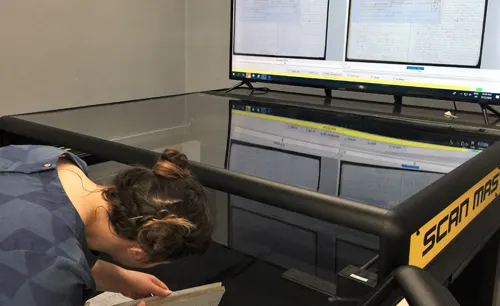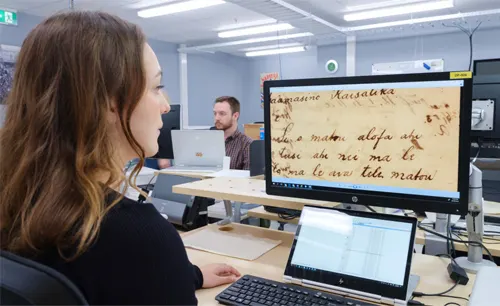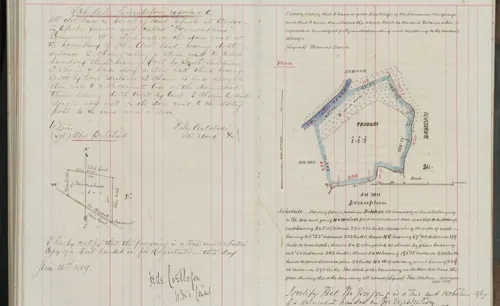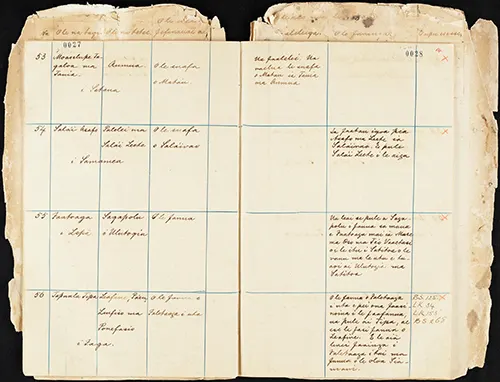Historic Sāmoan land information now available online
Accessing important archives about the historic ownership of land in Sāmoa has never been easier, thanks to the work undertaken by our digitisation team.
Introduction
Damaged by pests, heat and human neglect, many of the archives we hold from Sāmoa could only be viewed at our offices and on reels of black-and-white microfilm – the originals were just too fragile to issue. Now, advances in scanning technology and online access means people can view many of them on their own device and from the comfort of their own home.
We hold historic archives created by various governments in Sāmoa, from the foreign consuls of the 1850s to the German administration of the early twentieth century. Much of this material was found lying derelict across offices in Āpia, including piles of mouldy files stored in the old Vaimea Prison. They cover a wealth of subjects, from volcanic eruptions and the trial of notorious blackbirder Bully Hayes, to the actions of global empires and everyday Sāmoan life.
Journey to New Zealand
In the 1920s, and again in the 1950s, some of these archives were shipped to New Zealand for safe-keeping and with the understanding they would someday return to Sāmoa. In the meantime, archivists got to work repairing and copying the files, creating the microfilm used by researchers until very recently.
Among the bundles that arrived from Āpia were valuable items about land. Being able to access them online is a “massive achievement” says Dr Niusila Faamanatu-Eteuati, Lecturer in Sāmoan Studies at Victoria University of Wellington. “Land is fanua and is a very important measina to Sāmoans, connecting them to their family matai titles, their genealogies and faasinomaga.” Many travel all the way from Sāmoa to conduct research for court cases and to search for evidence of family land ownership. In a time of COVID-19 and closed borders, Niusila believes online access is timely and much needed.
Land information
The earliest Sāmoan land archives in our holdings include the buying and selling of land that was recorded by the British Consul. Between 1856-1915, copies of land agreements were written down in registers. Many of the registers were damaged by humidity: marbled covers crumble at the edges and spines no longer hold together. But thanks to their careful digitisation, researchers can flick through their pages with the click of a mouse, revealing names, dates, descriptions of the land, the amount paid, and the odd map. Some of the deeds are written in Sāmoan.
From 1868-1890, deeds were also recorded in the Lands Register, a large cloth-bound book from the Western Pacific High Commission archives. This register, complete with its own index, is fully digitised and available to view online.
In 1903, the German Colonial Administration of Sāmoa set up a Land and Titles Commission to investigate disputes between Sāmoans. While we don’t hold case files about each dispute, we do hold registers that note who the claimants and defendants were, the title and/or land under dispute, and the outcome of each hearing. These registers have been digitised, as have a small collection of papers that include the family tree of Uliuli (Tuatagaloa Uliulileave Fuimaono) and Afoa (Sinapaepaefoa Patea).
Other useful land information is scattered throughout the Sāmoan holdings, and we’ve digitised the most useful. These include Land Section registers from Āpia; village files from the British Military Occupation; English translations of German administration files covering all sorts of village and district matters, including war, politics and even the gift of an ‘alia, a double-hulled sailing canoe, to His Imperial Majesty; and the German files themselves. These Imperial files were digitised through a joint project between Sāmoa, Germany and New Zealand aimed at bringing the separated parts together digitally.
Digitisation
Dealing with fragile and flaky paper from the tropics is no easy feat. Germans clerks stitched pages together, while some of the damaged pages had also been separated from the volumes. Wikitoria Rakete, who led their digitisation, carefully aligned each page to their original place. As Emma Ravenhall notes, “extreme care was taken to ensure the land and title registers weren’t further harmed by the digitisation process.” Once they were imaged, multiple quality checks were carried out: post-capture, pre-ingest and a spot check online.

When it came to scan the British Consul deeds, the team used a highly specialised oversize capture machine. “Each page was gently flattened and individually scanned in a way that put very little pressure on the archives” says Chrissy Knight of the Digitisation team. Preservation during and after the scanning process was crucial. “Now that digitisation has been completed, the original deeds will undergo special preservation treatment to prolong their physical lives.” The original volumes were returned to the repository, preserved in their own custom-made boxes.

Access
Students and educators are already making use of the digital versions. “When students see historical records they are able to peer into their own histories and to reconstruct them in and for the present” writes Dr Emalani Case, Lecturer in Pacific Studies at Victoria University of Wellington. “Last year, while we experienced COVID lockdowns and when I could not physically take my students to the archives, we were lucky to be able to access digitised records online. Online access ensures that we can still engage with our histories in meaningful ways, even while physically grounded or distanced.”
Online access is also a driving force of the Pacific Virtual Museum, where many of these items are available to view. Funded by the Department of Foreign Affairs and Trade in Australia, digitalpasifik.org aims to empower people in and of the Pacific Islands, enabling them to see, discover and explore items of digitised cultural heritage that are held in collections around the world. Combined with our online channels, the Pacific Virtual Museum means even more people can view these significant land records online.
You can view the list of digitised items here on our website or via the Pacific Virtual Museum.
-
![A spread from one of the British Consul Deeds]() Click to expandA spread from one of the British Consul DeedsAEHA 18962 Box 9/ Volume 12
Click to expandA spread from one of the British Consul DeedsAEHA 18962 Box 9/ Volume 12![A spread from one of the British Consul Deeds]() Click to expandA spread from one of the British Consul DeedsAEHA 18962 Box 9/ Volume 12
Click to expandA spread from one of the British Consul DeedsAEHA 18962 Box 9/ Volume 12 -
![2 page spread from the Register of the Lands and Titles Commission]() Click to expandRegister of the Lands and Titles Commission, 1903-1921AGCA 6070 Box 107/ 871
Click to expandRegister of the Lands and Titles Commission, 1903-1921AGCA 6070 Box 107/ 871![2 page spread from the Register of the Lands and Titles Commission]() Click to expandRegister of the Lands and Titles Commission, 1903-1921AGCA 6070 Box 107/ 871
Click to expandRegister of the Lands and Titles Commission, 1903-1921AGCA 6070 Box 107/ 871 -
![Book cover of the Register of the Lands and Titles Commission, 1903-1921]() Click to expandRegister of the Lands and Titles Commission, 1903-1921AGCA 6070 Box 107/ 87
Click to expandRegister of the Lands and Titles Commission, 1903-1921AGCA 6070 Box 107/ 87![Book cover of the Register of the Lands and Titles Commission, 1903-1921]() Click to expandRegister of the Lands and Titles Commission, 1903-1921AGCA 6070 Box 107/ 87
Click to expandRegister of the Lands and Titles Commission, 1903-1921AGCA 6070 Box 107/ 87


